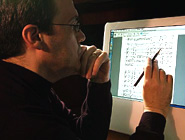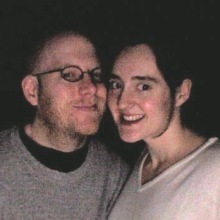 It’s a monster week for our gaucho amigo Lawrence Dillon whose music will be showcased at the Music Now Fest 2007, February 21, 22 and 23 at Eastern Michigan University. This is EMU’s 15th biennial new music festival and it gets underway on Wednesday at 8 pm with a concert of pieces by EMU composers Whitney Prince and Anthony Iannaccone as well as works by Steve Reich, Alberto Ginastera and others. Faculty artists include David Pierce, Willard Zirk, Garik Pedersen, John Dorsey, Kimberly Cole-Luevano, Kristy Meretta, Julie Stone, Kathryn Goodson and guest Cary Kocher.
It’s a monster week for our gaucho amigo Lawrence Dillon whose music will be showcased at the Music Now Fest 2007, February 21, 22 and 23 at Eastern Michigan University. This is EMU’s 15th biennial new music festival and it gets underway on Wednesday at 8 pm with a concert of pieces by EMU composers Whitney Prince and Anthony Iannaccone as well as works by Steve Reich, Alberto Ginastera and others. Faculty artists include David Pierce, Willard Zirk, Garik Pedersen, John Dorsey, Kimberly Cole-Luevano, Kristy Meretta, Julie Stone, Kathryn Goodson and guest Cary Kocher.
On Thursday, there will a composer convocation and welcome at 11 AM at Pease Auditorium where Mister Dillon will speak about “Furies and Muses: Composing in the 21st Century.” (My money’s on the Furies.) The lecture will be followed by open student ensemble rehearsals with Dillon and the EMU Symphony Orchestra and University Choir. Open rehearsals with the Wind Symphony and Symphonic Band are scheduled for Friday.
On Thursday night at 8 pm, there will be a faculty recital of the chamber music of Lawrence Dillon, including the aforementioned Furies and Muses, Dunigan Variations, Big Brothers and Facade. Winning composition(s) in the New Chamber Works for Horn competition will be premiered by sponsor Willard Zirk.
On Friday, there is a Meet the composer gig in the afternoon followed by the Festival finale a 8 pm–a concert by EMU’s major performing ensembles who will play Dillon’s Blown Away and Amadeus ex machina. Other works include Ogoun Badagris by Christopher Rouse; Spiel by Ernst Toch, Symphonic Band; and a piece by Anthony Iannaccone.
Presumably, on Saturday, Lawrence will go home and take a nap.
 Mike over at
Mike over at  On Sunday, Argentinean composer Osvaldo Golijov won two 2007 Grammy awards—Best Opera Recording and Best Contemporary Classical Composition—for his opera, Ainadamar (Fountain Of Tears) starring soprano Dawn Upshaw and the Atlanta Symphony Orchestra with conductor Robert Spano. In August of last year, WGBH Classics in the Morning host Cathy Fuller sat down with Golijov at his home in Brookline, MA and discussed this award winning opera, his first. This exclusive, in-depth interview—complete with excerpts from the moving opera—can be heard online at
On Sunday, Argentinean composer Osvaldo Golijov won two 2007 Grammy awards—Best Opera Recording and Best Contemporary Classical Composition—for his opera, Ainadamar (Fountain Of Tears) starring soprano Dawn Upshaw and the Atlanta Symphony Orchestra with conductor Robert Spano. In August of last year, WGBH Classics in the Morning host Cathy Fuller sat down with Golijov at his home in Brookline, MA and discussed this award winning opera, his first. This exclusive, in-depth interview—complete with excerpts from the moving opera—can be heard online at  Times have been good for my old composition teacher Lee Hyla. After many years on the composition faculty at Boston’s New England Conservatory, he has been hired into an endowed chair at Northwestern University, where he will take up residence in the coming academic year. His impending departure has precipitated a flurry of activity in Boston, including a lengthy and
Times have been good for my old composition teacher Lee Hyla. After many years on the composition faculty at Boston’s New England Conservatory, he has been hired into an endowed chair at Northwestern University, where he will take up residence in the coming academic year. His impending departure has precipitated a flurry of activity in Boston, including a lengthy and